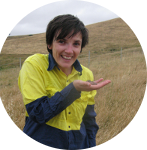-
Member Login
- Home
- About
- Institute Groups
- Membership
- Events
- News & Publications
- Institute Programs
- Resources
- Jobs Board
- Contact Us
- Site Info
Kelly Dalton
Kelly Dalton
Abstract | Use and effectiveness of glider pole linkages as a mitigation measure
The Sugarloaf Pipeline Project involved the installation of approximately 80km of pipeline to enable the transfer of water from the Goulburn River, Yea to the Sugarloaf Reservoir, Christmas Hills, Victoria. One of the post construction requirements of the Project was to establish glider poles as habitat linkages across the newly-cleared pipeline route (30 – 60 m wide) within Toolangi State Forest. The aim was to restore habitat connectivity along the forested sections (6 km) of the construction corridor in an effort to help gliding (volant) mammals (e.g., Greater Glider, Sugar Glider) cross the treeless corridor more safely. Eighty-three poles were erected across linkages at 37 locations. Some linkages had two poles (narrower construction corridor), while others had four (wider corridor).
Glider poles were monitored from 2014 to 2016 and involved spotlighting surveys, then the establishment of wireless motion-sensing cameras on a subset of glider poles to monitor the use and effectiveness of glider pole linkages. Spotlighting and cameras resulted in the detection of over 500 individuals of four volant species using the poles. Whilst it was determined conclusively that gliders were using the glider poles, it is unknown if gliders were actually gliding between poles and/or between poles and the forest, rather than just climbing the poles, due to the narrow field of view of the cameras.
Objectively, the project was successful in the sense that multiple individuals and species of gliders used the poles within the cleared corridor. However, whether gliders actually crossed the corridor using poles was not determined, therefore the effectiveness of poles as a mitigation measure to address the fragmentation within the forest remains unknown.
For future studies, modifications to the method and information collected would be required to determine the effectiveness, including changes to camera set up and survey effort prior to mitigation establishment.
Bio | Kelly Dalton
 Kelly Dalton is a zoologist and team leader at GHD. She has 11 years of experience as a zoologist; with nine of those in ecological consulting, where she utilises a broad range of survey methods and applications for all vertebrate faunal groups across numerous projects with a broad diversity of project objectives.
Kelly Dalton is a zoologist and team leader at GHD. She has 11 years of experience as a zoologist; with nine of those in ecological consulting, where she utilises a broad range of survey methods and applications for all vertebrate faunal groups across numerous projects with a broad diversity of project objectives.
As a consultant with a large engineering firm, Kelly frequently encounters the intersection between people and linear infrastructure. Kelly has a keen interest in arid and semi-arid environments and working with reptiles and small mammals but works across all habitats and with all faunal groups. Kelly’s work and interests have taken her to project locations in all states and Northern Territory. Kelly conducts desktop flora and fauna assessments, fauna habitat assessments, targeted threatened fauna surveys, targeted flora surveys, ecological impact assessment, ecological monitoring, experimental design and research, habitat mapping, preparation of management plans and the provision of recommendations to both minimise and mitigate against environmental impacts.
One of the largest projects Kelly has been involved with was the Sugarloaf Pipeline Project in central Victoria, and her presentation is based on one component of wildlife management for that project.
We acknowledge and value the rights and interests of Indigenous Peoples in the protection and management of environmental values through their involvement in decisions and processes, and the application of traditional Indigenous knowledge.

